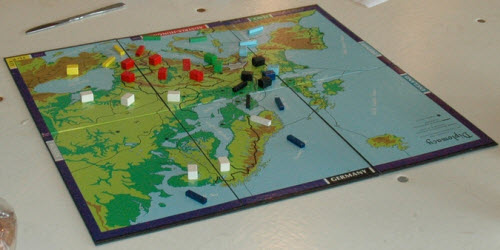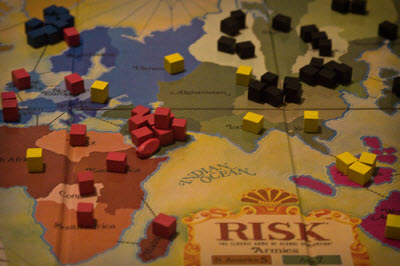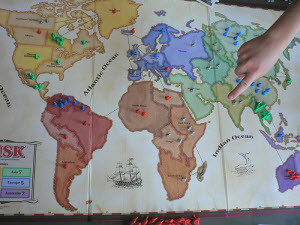Among board games, genres are often defined by their assumptions. Co-Op games assume that the players will work together to win. Worker Placement games assume a steady economy of actions. Monopoly presumes a certain economic savvy about good investments versus bad investments (even if it doesn’t often pan out that way). And war games assume that there can be only one true victor.
War games don’t generate the same gaming attention as other genres nowadays, but they remain a strong category of board games, with new entries and new variants on existing games arriving every year. As a genre, war games involve simulating military conflict between rivaling powers, capturing territory, and exploiting tense alliances for positional gain. They also can contain many immersive elements, such as named leaders, unique units, and seasonal shifts. Tabletop tacticians will have enough elements on the table to possibly find the Nash equilibrium of the best possible moves. Most tellingly, war games are known for their length of play, if nothing else, with games going for hours (or possibly days) to resolve. Even with the shifting alliances and clever gambits, however, most war games can only have one winner, and that is typically the last player standing.
Diverged Progenitors
As one of the most prolific forms of board gaming in the 20th century, many games draw their inspiration from the classic war games. More than a few modern design mechanics were borne out of, or in response to, these types of games. Of the classics, two games stand as titans in the genre: Diplomacy and Risk.
Diplomacy was released in 1959, and it features a game for two to seven players engaging in the military conquest of Europe and surrounding territories. Modeled after World War I, Diplomacy focuses on the secret alliances that gave rise to the Great War, with the only truly random element being the allegiances of your fellow players.
Risk establishes a similar backstory and premise. Originally published in France in 1957, it was swiftly brought to the United States later that decade. It has a more generic setting, though one that has been been tried multiple times over the centuries: global dominion. It is a game of world conquest for two to six players, and it utilizes a deck of cards for resources and dice for combat success.
These two games are still considered staples in many board game collections, and over the decades they have had an immeasurable impact on the hobby. While they may seem very similar at first glance, however, players familiar to both games quickly learn how drastically different the games are in play.
The (Mostly Complete) Rules
Risk deals with nations of the world gathering forces and launching assaults to claim each other’s territory. Depending on the variant, players either have complete control of where their armies start, or it’s randomly determined at the start of the game by dealing out a deck of cards consisting of the forty-two territories and one of three symbols. Players then take turns, consisting of them moving their armies to consolidate territory and taking it from their opponents.
At the beginning of their turn, a player receives additional army units based on the number of territories they control, with bonuses for controlling entire continents and/or for having matching cards in hand.
Then, a player will almost always make an attack on a neighboring territory. When an army attacks a territory controlled by an opponent, the two players roll six-sided dice based on their army sizes. The highest roll wins, with ties going to the defender. The losing player of that roll removes one army from the attacked territory. This continues until only one side still has units present or the attack is called off.
Once one territory has been resolved, the player may choose a new territory and repeat the process. They continue to do this until they choose to stop or run out of resources. At the end of the turn, if that player conquered a territory, they draw a card from the deck. Play then passes to the next player, who follows the same structure. Turns continue until one player is the only one with pieces left on the board.
Diplomacy is more specific thematically in that it focuses on the European Theater at the start of World War I. Players are assigned (or may choose) their nations, consisting of England, France, Germany, Italy, Austria-Hungary, Turkey, and Russia. Players then receive a set of starting troops in the same starting locations each game, with both naval fleets and armies. Play in Diplomacy consists of calendar years, with each year having a Spring Turn and Autumn Turn.
Each turn begins with a pre-set length of time for negotiation. Players are encouraged to make arrangements with one other, promise assistance, and myriad other things. Once time is up, all players secretly write down their orders for what each of their armies and navies will do that turn. When all orders are turned in, they are revealed and executed simultaneously. Units may attack adjacent provinces, support the defense or attack of a province, or stay put and do nothing. During an attack, the side with the most units triumphs, with ties resulting in a standoff. If a province containing an army is attacked, any support it gave is cancelled. The defeated unit retreats to an adjacent empty province if possible, and if not, it is destroyed. The winner of the attack is now deemed to be in control of that territory. Several locations hold strategic importance, such as those with Supply Centers that can increase your nation’s production.
At the end of the Autumn Turn, players claim any Supply Centers for their nation that their units occupy and recalculate their Supply Total. They may then place new units in provinces containing their original Supply Centers if their production has increased, or remove units from the board until their number of units is equal to their Supply Total if it decreased. If a single player controls at least 18 of the 34 Supply Centers in the game, they win.
Board Game Senior Citizens
Both Risk and Diplomacy offer a wealth of strategies for play, and each have had a lengthy and distinguished history. Both are popular tournament games, and each has dozens of variants that see frequent play. Both games easily have a play time lasting many hours, and each has a method of economic momentum to their armies. Moreover, each offers a clear path to victory that favors a strong tactical intelligence and a careful balance of available resources. They also share the flavor element of nations clashing for geo-political power through the use of their military might. It is there, however, that the similarities end.
Diplomacy has a reputation as a game that can ruin friendships, and it is well-deserved. As much as Diplomacy is a game of negotiation, it is also a game of betrayals at the best possible moment to claim victory. The game’s depth and nuance relies on player actions far more than mechanics. Not every faction is as likely to succeed as others, and there is no randomness to prevent a well-planned push from wiping a player out.
As a result, with all its meticulous planning of moves and counter moves, Diplomacy can take an exceptionally long time to play; games taking well over 12 hours are not unheard of. Diplomacy has a vigorous play-by-mail community to it, which can mitigate this somewhat, but you don’t get the added tension when the other players aren’t physically present.
Risk, contrarily, is a game where chance is the kingmaker. Random elements often lead to large swings in the late game especially, as the dice rolls dictate the vast majority of combat situations. A few bad rolls of the dice and a push to take territory can flounder after the first conquest due to a loss of troops. Likewise, a sudden surge can be created from turning in the right cards, and this can turn the tide from a guaranteed loss to an even fight. Whereas Diplomacy’s allegiances are hidden, it is the enemies’ potential which is instead hidden in Risk.
A War With Patience
Both games are the foundation upon which later war games were developed, and their impact on the hobby cannot be disputed. Their acceptance into popular culture has made them games commonly played with family members and casual hobbyists with a day to spare. Like most war games, they are ultimately the domain of the battlefield-friendly Tactician, usually serving as a crucible in which they discover the truth of their archetype. For the Immersionist and Socializer, Diplomacy offers both the feel of a continent teetering on the brink of war and an excellent excuse to spend a day with friends. A Tactician / Socializer at a Diplomacy table is nearly always a force to be reckoned with. It should be noted, though, that as rules-light as both these games tend to be, most Socializers may have issues seeing one of these games through to fruition more than once in a blue moon due to the time involved.
Risk, on the other had, is a little too abstract and focuses too heavily on the dice results to appeal to Tacticians and Immersionists. Negotiation matters far, far less when all players but the winner must be eliminated.
However, both Daredevils and Strikers will find Risk to be closer to their motivations in games, as bold strikes against your fellow players can lead to surprising success, and hot dice with good cards can turn a player’s fate entirely around. Strikers may grow tired of all of their success hinging on constant dice rolls, but this will likely still be favorable compared with having to negotiate and rely on other players as in Diplomacy.
Sadly, neither game brings much to the table for the Architect. Both Diplomacy and Risk focus on conflict between players, and after a very short early game, both reach a zero-sum balance. The only way to expand your resources is to take them from someone else. While Diplomacy does have both fleets and armies, there is otherwise nothing unique about any given unit in either game. Momentum is gained solely by attacking, and aside from tactical merit, there is little benefit to any one territory over another. With the length of either game in mind, and the lack of an effectively neutral strategy, an Architect would find being in either setting to be overly long and equally boring.
As war games developed in the 50 plus years since these two classics were invented, they have not only refined their own style, but they have helped give rise to modern tabletop design as we know it. Whole new genres of tabletop games can thank these early war games for what were innovative ideas at the time. These two veterans embody the two endpoints along the Luck vs. Skill line, with each standing at one end facing one another. Yes, in the modern era both games have begun to show their age (Risk a little more so than Diplomacy), but with new variants and still possessing recognizable names for over half a century, these two continue to resonate with audiences posturing for some traditional worldwide conquest. The question as these audiences approach these iconic classics then becomes whether they’d prefer to do so via luck of the dice, or careful and thick-skinned political intrigue. They’re fairly simple, often memorable, and have easily attained iconic status for their many years of dedicated service.
Photo Credits: Diplomacy board by sponng; Classic Risk board by Rosalyn Davis; Risk pieces and board gesture by Willow & Monk; Firefly image by PPC Wikia.





